by Winding Pathways | Jul 14, 2022 | Garden/Yard, Garden/Yard
Gardeners across the world proudly bring freshly picked vegetables and fruits into the kitchen. They’re lucky to have an amazing array of delicious plants to grow and enjoy. It wasn’t always that way.
Consider Native Americans. Prior to Columbus, many lived in cities and big towns surrounded by gardens and farm fields. They grew corn, beans, and a diversity of squash and pumpkins, but they knew nothing of many of today’s common vegetables. Residents of Asia, Africa, Europe, and Australia back then also farmed and gardened, but their crop choices were limited.
-
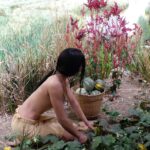
-
Many foods were cultivated by indigenous people.
-

-
Cahokia Mound
New World & Old World

Indigenous contacts ranged far and wide.
It changed quickly following what’s called the Great Columbian Exchange. Shortly after Columbus set foot on Hispaniola people began deliberately and purposefully moving plants and animals around the world. Many were valuable and diversified the food chain on all continents. Others quickly became pests………most weeds infesting American gardens originated in the Old World.
Imagine Southern Italian cuisine without tomatoes! This delicious vegetable originated in South America and was unknown in Italy before the Columbian Exchange. Same with potatoes. The Irish potato originated in South America.
It went both ways. Today’s gardeners enjoy vegetables originating all over the globe. Here’s a brief list of where common foods came from:
NATIVE OF THE NEW WORLD
Pumpkins and squash, Beans except for fava, Corn, Potato, Sweet Potato, Tomato, Pepper, Jicama
-
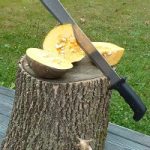
-
A machete is useful in cutting squash.
-
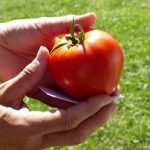
-
The sweetness of summer’s bounty.
-
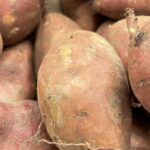
-
Sweet potatoes are a healthy vegetable.
NATIVE OF EUROPE, ASIA, and AFRICA
Watermelons and cantaloupes, Onions, leeks, and garlic, Turnips, Carrots and parsnips, Yams, Radish, Celery, Asparagus, Beets, and Chard, are the same species, Cabbage, Cauliflower, Brussel Sprouts, Broccoli – all related, Endive, Lettuce, Rhubarb, Spinach, Okra, Cucumber, Peas.
The Columbian exchange also included grains and fruit. Corn is American but wheat, barley, rye, and oats are from the Old World. Apples, peaches, pears, and cherries (except for the bitter American black cherry) are also Old World. Brambles and strawberries apparently lived in both the Old and New Worlds prior to Columbus. Grapes eaten fresh and used for juice and wine came from the Old World but several species also are native to the Americas.
-
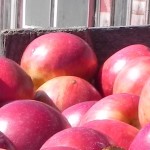
-
A favorite fall harvest is apples.
-
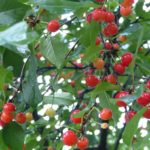
-
Tart cherries come ripe in June.
Thanks to the movement of useful plants gardeners worldwide enjoy a diversity of plants to grow and eat.
by Winding Pathways | Jul 7, 2022 | (Sub)Urban Homesteading, Chickens, Garden/Yard, Nature, Weeds
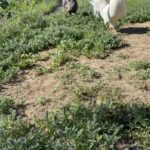
Chickens in run
A chicken run is one tough place for plants to live, and our run at Winding Pathways is even tougher than most.
Every day we let our chickens roam around the run. A bright baking sun broils the sandy soil all day long, so it’s hard to imagine that any plant can thrive there. And, chicken run plants face another challenge. The birds love greenery and usually devour every plant they find. As a result, most chicken runs are just bare dirt that’s either dusty or muddy.
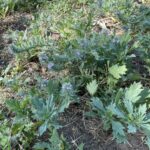
Flower and leaf
Big Bracht Verbena (Verbena bracteata), sometimes called Prostrate Vervain, is up to the challenge. It carpets our chicken run. We didn’t plant it. Verbena moved in on its own. Hopefully, our chickens enjoy viewing the plants’ tiny soft blue flowers.
Big Bracht Verbena is common across much of North America, but it’s easy to overlook. Rarely causing problems, it lives in the most difficult environments. The plant thrives in hot dry gravel soil along roads, in vacant lots, and in sidewalk cracks.
We like having this humble plant in our chicken run. It covers the soil, eliminating mud that follows rain. Chickens absolutely won’t eat it, but they love snatching the insects lured to the plant. It needs no human care, but we sometimes mow it if it gets a big shaggy by late summer.
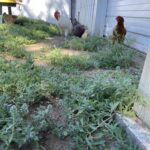
Foraging among verbena
One of nature’s mysteries is how plants have adapted to thrive in all sorts of environments, even harsh ones. Hats off to Big Bracht Verbena.
by Winding Pathways | Jun 30, 2022 | (Sub)Urban Homesteading, Garden/Yard, Garden/Yard
Varied Garden Produce
Midsummer. It’s the heart of gardening season as millions of Americans proudly bring tomatoes, beans, squash, and a host of other crops into the kitchen from the backyard garden.
Many don’t realize they ignore eating a typical garden’s hidden delightful food.
Most gardeners spend hours pulling and hoeing incredibly common and prolific garden weeds, only to toss them out. They make delicious food.
Here are our favorite “weeds” to eat
Lambsquarters. The young leaves of this persistent and fast-growing plant are delicious in salads. Or they can be boiled and used like spinach.
Amaranth or Pigweed. Sometimes called wild beet. Almost as common as lambs quarters, the young leaves can also be used similarly to spinach.
Purslane. This ground-hugging hot weather weed is a commercial crop in India. Young leaves and stems are delicious raw. They can also be boiled or even pickled. Grit tends to cling to purslane so rinse it thoroughly.
-
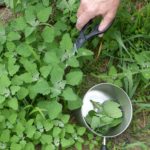
-
A full pot of raw Lamb’s Quarters cooks down to a few fork fulls of this nutritious potherb.
-

-
The Latin name is Portulaca oleracea
Crops with Rarely Harvested Edible Parts
Our favorites are
Beet greens. Beets are the same species as Swiss chard but the leaves tend to toughen as the plant grows. We use young beet leaves as we would chard.
Sweet Potato leaves. We haven’t tried these yet but will this summer. From what we’ve read they are delicious steamed and can be eaten raw.
Squash and pumpkin blooms. These plants usually produce more blooms than they need. We sparingly pick and steam them for a colorful yellow vegetable.
Carrot tops. Our master gardener friend thins carrots and uses the tops in pesto. We tried this in a pesto that a friend shared. Delicious!
Radish tops. Mix a few young leaves into salads. They’re spicy and add zest to other greens.
-
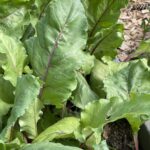
-
Beets are a cousin to Swiss Chard
-
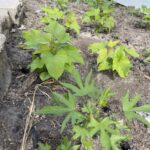
-
Sautee or mix in a salad
-
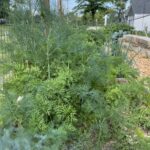
-
Add to pesto!
-
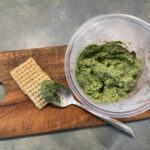
Resources
Whenever eating a new plant for the first time, make sure the identification is correct. It’s smart to identify a wild plant from at least three sources. These might include an Internet search, a wild foods book, or identification by a trusted wild food or garden expert. One online source is www.wildedible.com. Once you’re certain it’s edible, eat a small helping the first time to make sure you like it and it likes you.
by Marion Patterson | Jun 2, 2022 | Chickens, Garden/Yard, Geology/Weather, Hoover's Hatchery, Preparedness, Reflections/Profiles, Travel/Columns
Coming up to a year from the last post on the features we wrote for the Cedar Rapids Gazette, here is an updated list for the second half of 2021 and the first half (almost) of 2022. These features are in addition to our regular work with Hoover’s Hatchery blogs and FB Live and our own blogs for Winding Pathways.
May 8, 2022. Splish Splash! Whitewater Kayaking in Iowa. (No link to date)
April 22, 2022. Finding America On Roadways East.
April 13, 2022. Muscle Over motor When Boating.
March 21, 2022. Rockhounding.
January 30, 2022. Backpacking Bonus. (8B of GZ. No link to date) Available Green Gazette.
January 24, 2022. Distinctive Religious Structures.
January 16, 2022. Hiking Wild Areas. (no link to date) Available Green Gazette.
December, 2021. Country Schools. (no link to date) Available Green Gazette
November 15, 2021. Making a (Mini) Pitch for Soccer.
October 6, 2021. A visit with Midwest’s Pioneering Authors.
September 8, 2021. Taking a Slow Boat to Cassville.
September 6, 2021. Camping in Iowa’s Trout Country & Decorah’s Celebrities.
August 4, 2021. Parking While Headed East. And Solar Panels at Peoples.
by Winding Pathways | May 26, 2022 | (Sub)Urban Homesteading, Garden/Yard, Garden/Yard, Preparedness
Good Friday Tradition
On a cold April morning, we planted a row of potatoes at Winding Pathways. This plant has made an amazing long journey to reach our yard.
Potatoes are native to South and Central America and were cultivated by native people long before Columbus. Early Spanish explorers realized this humble American plant produces an enormous amount of food that’s easy to store. They brought potato sets back to Spain, and eventually, the plant was cultivated throughout Europe.
-

-
Sweet potatoes are a healthy vegetable.
-
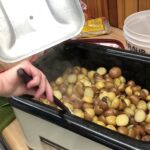
-
Potatoes are hardy and plentiful.
Productive Crop
Potatoes produce more human food per square foot than wheat, rice, corn, or nearly any other crop, so crowded Ireland embraced the plant. Potatoes thrived in Irish soil and were so productive they enabled the human population to flourish. Unfortunately, the entire crop was of just one or two varieties. Disaster hit. Between 1855 and 1859 blight killed most of the crop, which lacked resistance to the disease. It caused massive starvation and spurred huge immigration to the United States.
Early Europeans who colonized North America brought potatoes to plant in the New World. So, an American plant crossed the Atlantic Ocean twice in its long journey.
Vandals and Hawkeyes
We both hold degrees from the University of Idaho. It’s the potato state, and the plant loves the light volcanic soil along the Snake River in the southern part of the state. Iowa, where we live, is the corn state, but humble potatoes do well in our garden.
We buy seed potatoes in early spring, cut and cure them, and plant them in early April. They don’t expect much from us, and by mid-summer we carefully hand dig delicious new potatoes. Later, when the tops die back, we dig and cure a bushel, or so, for winter storage.
Expert Resource at Hand
We hedge our bets by planting a few potato varieties, and this year we’re fortunate to have a potato expert move to Cedar Rapids. Jean Contina earned his doctorate degree from the University of Idaho studying potato diseases. He’s a fellow Vandal! We’ll seek his advice on how to maximize our crop.
-
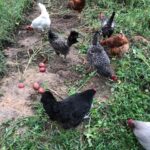
-
Chickens don’t seem to bother the potatoes.
-

-
Beautifully presented dinner.
Inexpensive. Why Grow Them?
Store-bought potatoes are one of the least expensive foods. So why grow them?
We have two reasons. First, anything we grow seems more delicious than its store-bought counterpart. It may be our imagination but it is true. Second, they are an easy crop to grow and store well all winter without the need to can or freeze them. Having potatoes stored in a cool dark room in our house gives us a bit of food security in a crazy world.
by Winding Pathways | May 19, 2022 | (Sub)Urban Homesteading, Foraging, Garden/Yard, Weeds
Yes! The blossoms and leaves have vital nutrients and were cultivated by our European ancestors. In the modern world, every year homeowners spend money and elbow grease to poison their lawns all to try to rid their lawn of dandelions. They could sell the dandelions instead!
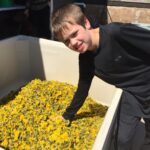
You can make money selling dandelion blossoms.
What? Sell dandelions? The Ackerman Winery in Amana, Iowa, crafts delicious dandelion wine. To make it they need thousands of the plant’s golden blooms and they pay $8 a gallon for them.
The dandelion season has faded for the 2022 spring, but we’ve seen lawns with many dollars’ worth of blooming dandelions that could have been sold. For information on how to buy dandelion wine or sell dandelions go on the Ackerman Winery website.
About Dandelions
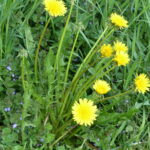
By mid-summer dandelion leaves are tough and bitter.
Dandelions are an amazing plant. Native to the Old World, their seeds were brought to America on the Mayflower. For thousands of years, people considered them a valuable resource. By late winter people often suffered from vitamin deficiency. Dandelion leaves are rich in vitamins and green up in early spring. People ate them to restore their health. They are as nutritious today as they were in the past.
Only in recent years have dandelions been considered pests. Because they are prolific, common, and easy to identify, chemical companies encouraged people to view dandelions as pests so they could sell herbicides.
How silly it is to spend money to kill plants that are good to eat and so nutritious. Thanks to Ackerman Winery they can even add to a family’s income.
How People Unwittingly Encourage Dandelions
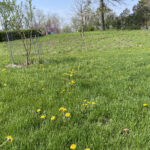
Mowing low encourages dandelions.
Observation reveals a dandelion secret. They thrive on mowed lawns and rarely grow in prairies, woods, or wetlands. Mowing invites dandelions to move in, and chemical companies are ready to sell potions designed to kill a plant with a remarkable relationship with people. A natural way to reduce dandelion numbers in a lawn is simply to set the mower to cut at its highest level. It leaves the grass a big shaggy but their leaves shade the ground and discourage dandelion growth.
We enjoy dandelions at Winding Pathways and steam young tender leaves every spring.























